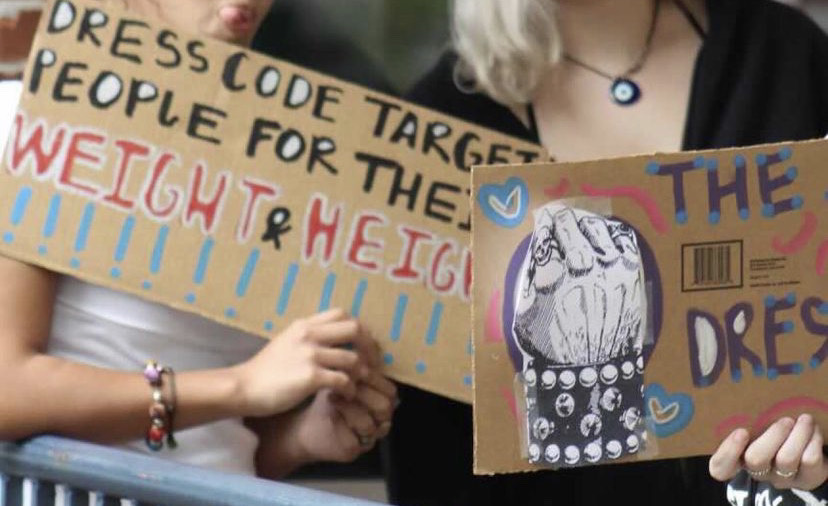Dress Code: A Call for Change
The Bob Jones High School student dress code protest
October 1, 2021
Earlier in the school year, students of Bob Jones held a protest against the school-mandated dress code. A group of students from all grades and all ages came together, made signs, and stood together to protest for what they believe in. Instead of sitting back and letting the school system define how they should dress, students decided to take a stand and protest what they believe in. An action like this takes a lot of courage. These students spent a lot of time organizing the event, creating signs, and spreading their message. Many of the students found issues within the school dress code. An example of this is students not being able to show their shoulders, midriff, or upper thighs and being reprimanded if these expectations aren’t met. Most of the students believe that the dress code is unfair because it specifically targets young girls as well as sexualizing them. Countless students claim they feel extremely sexualized when they are told that their shoulders, stomach or thighs are a “distraction”.
In The Atlanta Journal-Constitution, Maureen Downey stated, “In the 2017-18 school year, 42.6% of elementary schools, 61.6% of middle schools and 55.9% of high schools reported they enforced a strict dress code for their students, according to the National Center for Education Statistics.” More than half of all high schools in the United States enforce a strict dress code. TODAY surveyed 17,000 people between the ages of 18 and 64 on their opinion about school dress codes and the results are as followed: 51% responded “It makes me feel uncomfortably hot or cold,” 33% responded “It forces me to spend more money on clothes,” 29% responded “It limits my comfort and makes me less productive,” 22% responded “It limits my freedom to express myself,” and 13% responded “It targets my gender in unfair ways.” The bottom line is that students have fought against their schools’ dress code for years. Some students make such an impact that their school hears them and changes their dress code. This is the goal of many students at Bob Jones High School. The students wish to dress how they want to without feeling uncomfortable or sexualized.
These dress codes undoubtedly target young girls specifically. Dress codes often enforce that women can not wear tank tops, while men are still allowed to. Men also constantly wear shorts that are above their fingertips and are rarely told to change. The dress code is not enforced on the boys as strictly as it is on the girls. This shows that the dress code rules are not equal for men and women. The dress code is targeted at the female students while the male students rarely get dress coded. Many of the boys at Bob Jones High School also see the sexist dress code enforcement and believe that it is wrong. They clearly see that women are dress coded more often than they are, even if they wear the same types of clothing. One of the boys at Bob Jones High School said, “Young women are especially targeted in the dress code and should be able to dress freely and comfortably.”
When dress codes are enforced on students, this often causes the students to lose class time. They are pulled out of their class for being a distraction. This creates an even bigger distraction by bringing all the classmates’ attention to the student being removed from class. This leaves the student feeling embarrassed and ashamed. Removing a student from class or asking them to change creates a bigger distraction than the distraction the dress code tries to prevent. Alyssa Pavlakis and Rachel Roegman of Phi Delta Kappan comment on school dress code enforcement: “When students are disciplined because of how they are dressed, they lose class time — for a five-minute hallway lecture, 20 minutes to search through a bin of “appropriate” clothes to wear, an hour-long trip home, or even a full-day suspension.” This places the fault on the person being dress coded, not the person who is “distracted.” Neon, a freshman at Bob Jones states, “Someone doesn’t deserve to have their education disrupted based on what other people see them as.”
Many students claim to feel uncomfortable and unsafe because of their school’s dress code. This shows young students that they are constantly being looked at and judged by their clothing. Being told to “cover up” makes students feel unsafe around administration, teachers, or other students. Telling young students that their clothing is too revealing or promiscuous tells them that the school is looking at their body specifically and not them as a student. Every student has the right to feel safe and secure in their school.
The dress code specifically targets women. This is even more specified by race, weight, and body type. Black women are typically dress coded more than white women and women who have a wider body frame are dress coded more strictly. This shows that the dress code is not enforced equally amongst all students. Students at Bob Jones High school are not allowed to wear head coverings like hats unless they are used for religious purposes. This prevents certain people from wearing specific head coverings to protect their hair, specifically targeted at black students. The school dress code even discriminates against people based on their body type. Even if the length of a shirt was the same on two different students with two different body types, one is dress coded and the other is not. This is especially seen in students with wider shoulders and bigger chests, being dress coded about the same clothes as someone with a smaller frame or smaller chest would wear. This shows that the dress code specifically targets people based on their body type. Women with wider thighs are more likely to be dress coded than other students with smaller thighs. This shows that the teachers who enforce the dress code specify it on the students’ body type.
Many of the students are left feeling embarrassed and ashamed after being dress-coded. Unwanted attention is brought to them. When other people’s attention is drawn to their bodies, they are left feeling embarrassed and even insecure. The dress code encourages students to “cover up” to remain safe. The students shouldn’t have to cover their shoulders, midriff, and thighs to feel safe in their school. In an NJSBF “Informed Citizens Are Better Citizens” article on school dress codes, Michael Barbella stated, “An informal survey conducted by NEA Today found that teachers generally support dress codes, claiming they prepare students for how to present themselves in the real world.” This suggests that the teachers are saying that the way students dress determines how they are seen.
Young women being punished and taken out of class because of their clothing holds them accountable for the actions and thoughts of others. The eyes of someone else are not the young woman’s responsibility. Harrison Taff, a student at Bob Jones high school comments, “If there are people in this school who are distracted by people’s skin (shoulders, stomach, upper knee), then they are the problem, not the young women.” If the sight of a student’s shoulders, stomachs or thighs distracts another student or teacher, it is their responsibility to control themselves and not the person’s responsibility to change. If a teacher asks a student to change their clothes, they are saying they pay more attention to the student’s outfit than their education.
The reason that some of the students at Bob Jones High School protest the school dress code is because they feel unsafe, sexualized, unable to express themselves, and unfairly punished. The students call for change.


